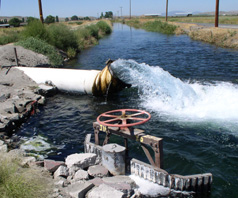|
 |

July 18, 1918 Link River often went dry before the Klamath
Project was built.
Myth: There was more water in the Klamath River before
the Project was built.
Fact: Link River has never gone dry since the
Project was built. The Project raised water levels
in the lake and river
for irrigation, fish, and power. |
 |
|
1905 Tule
Lake before the Klamath Project was built.
Myth: Klamath Basin was a desert.
Fact: See photo above. Does it look like a desert? It was a lake
up to 30' deep.
Myth: Irrigators use more water than the historic lake.
Fact: More water evaporated from the historic lake than is used by
irrigators.
Myth: The above Tule Lake used to continue into the Klamath River
raising lake levels for fish.
Fact: NO water ran from Tulelake into Klamath River. It
did not go to Lower Klamath Refuge either. A tunnel was built, D Plant,
part of the Klamath Project, to PUMP water into L K Refuge and on
to Klamath River. Tule Lake was a totally closed basin. |
2000 When the Klamath Project was built
(and paid in full by irrigators) water was rerouted
into canals and reservoirs for irrigation, wildlife
and power. There are over 1500 shoreline miles
of habitat along canals in Tulelake Irrigation
District alone. Grown are barley, wheat, oats, peas,
beats, alfalfa, pasture, potatoes, onions, mint,
rye, horseradish. Tulelake Basin grows 1/3 of the
nation's horseradish. |
|
 2001
When the Bureau of Reclamation shut off water to 1400 Klamath
Project irrigators, it also damaged habitat for over 489 species
of wildlife. This was the first time in recorded history
that this land, and wildlife, was without water. Also,
the farm community lost $200,000,000. Later, the National Academy
of Science, NAS, said that the water shut-off was "not
justified." This was an independent team of scientists and their
conclusions were peer reviewed, unlike the draft biological
opinion shutting down the Project. The NAS also said that lake
level, river flow management was not scientifically justified.
Unfortunately, this unscientific biological opinion still drives
the Project Operation.
2001
When the Bureau of Reclamation shut off water to 1400 Klamath
Project irrigators, it also damaged habitat for over 489 species
of wildlife. This was the first time in recorded history
that this land, and wildlife, was without water. Also,
the farm community lost $200,000,000. Later, the National Academy
of Science, NAS, said that the water shut-off was "not
justified." This was an independent team of scientists and their
conclusions were peer reviewed, unlike the draft biological
opinion shutting down the Project. The NAS also said that lake
level, river flow management was not scientifically justified.
Unfortunately, this unscientific biological opinion still drives
the Project Operation. |

In
2005 100,000 acre-feet water bank mandated
by the National Marine Fishery Service, Bureau of
Reclamation puts
stored water and aquifer into Klamath River.
Regardless of historic lake levels and river
flows, this water is annually taken from the
irrigators. Paid, yes. Choice, no. Fair price, no.
Wells have dried up. The lake level/river flow
management deemed scientifically unjustified by the
NAS is still being used to take Project water.
|
SEE
bottom map below.
Study it carefully.
Myth: Irrigators take all their water out of the
Klamath River, drying up the river.
Fact: Irrigators mostly take water out of the water stored in Klamath
Lake and Reservoirs.
|



 2001
When the Bureau of Reclamation shut off water to 1400 Klamath
Project irrigators, it also damaged habitat for over 489 species
of wildlife. This was the first time in recorded history
that this land, and wildlife, was without water. Also,
the farm community lost $200,000,000. Later, the National Academy
of Science, NAS, said that the water shut-off was "not
justified." This was an independent team of scientists and their
conclusions were peer reviewed, unlike the draft biological
opinion shutting down the Project. The NAS also said that lake
level, river flow management was not scientifically justified.
Unfortunately, this unscientific biological opinion still drives
the Project Operation.
2001
When the Bureau of Reclamation shut off water to 1400 Klamath
Project irrigators, it also damaged habitat for over 489 species
of wildlife. This was the first time in recorded history
that this land, and wildlife, was without water. Also,
the farm community lost $200,000,000. Later, the National Academy
of Science, NAS, said that the water shut-off was "not
justified." This was an independent team of scientists and their
conclusions were peer reviewed, unlike the draft biological
opinion shutting down the Project. The NAS also said that lake
level, river flow management was not scientifically justified.
Unfortunately, this unscientific biological opinion still drives
the Project Operation.

